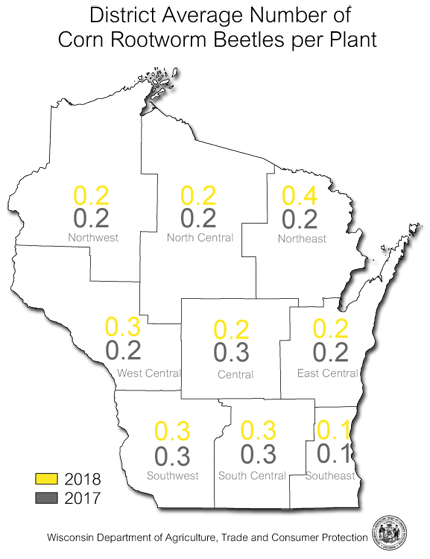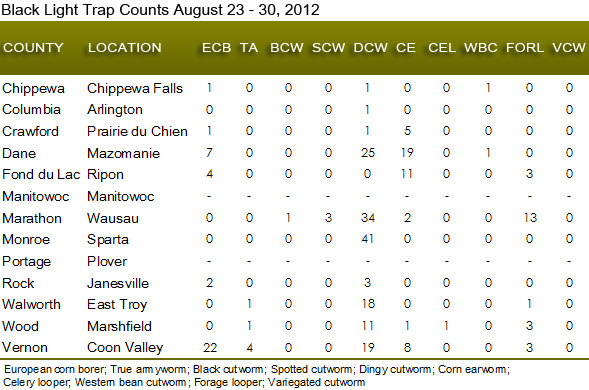
 |
|
|
Corn
Volume 57 Number 20 Date 08/30/2012 CORN EARWORM - Moths appeared in very high numbers in pheromone trap collections again this week. Counts at the Dane and Fond du Lac County monitoring sites ranged from 125-1,092 per trap. The latest activity signals that the threat to late sweet corn plantings has intensified. Pheromone trap counts for the August 23-29 reporting period were as follows: Bloomington 87, Columbus 125, Coon Valley 20, Janesville 25, Marshfield 1, Ripon a 651, Ripon b 1,092 and Wausau 0. CORN ROOTWORM - The beetle survey conducted from July 20-August 17 found relatively high counts in corn across the southern three crop reporting districts and low to moderate populations elsewhere. District averages ranged from 0.8-0.9 beetle per plant across the south, where 33 of 98 (34%) fields sampled had economic populations of 0.75 or more per plant. Beetle counts decreased in central Wisconsin and increased in the north. District averages in these areas varied from 0.3-0.6 per plant (see map below). Based on the results of the annual survey, non-Bt, continuous corn in the south is at increased risk of root damage as overwintered larvae hatch next season. However, individual fields with economic counts were found in all areas and these sites are also at risk if replanted to non-Bt corn in 2013. EUROPEAN CORN BORER - A third flight is in progress in the southern, central and western areas. This flight may result in a higher population of overwintering larvae and a larger emergence of moths next spring. The larval abundance survey in September should reveal any significant change in the fall corn borer population. CORN WILT DISEASES - The incidence of Goss's wilt in Wisconsin seed corn fields decreased significantly in 2012. After two consecutive years of elevated disease rates, only three of 57 (5%) corn leaf samples tested positive this season. Disease incidences were 34% and 62%, respectively, in 2011 and 2010. The hot, dry weather of July appears to have reduced its occurrence, while in the preceding two years, heavy precipitation, frequent storms and extensive wind damage favored its development. Corn leaf samples were also tested for other diseases of export significance, including Stewart's wilt and wheat streak mosaic virus (WSMV). Results for both diseases were negative. --Krista Hamilton, DATCP Entomologist 


|
|
|